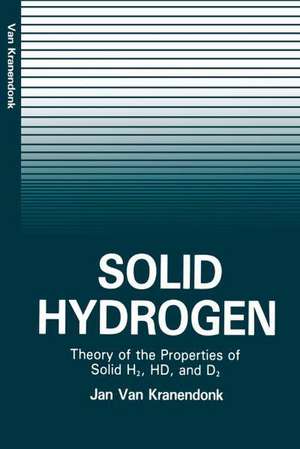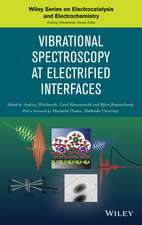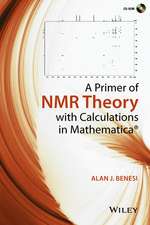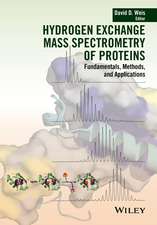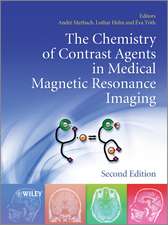Solid Hydrogen: Theory of the Properties of Solid H2, HD, and D2
Autor Jan Kranendonken Limba Engleză Paperback – 27 iul 2013
Preț: 389.11 lei
Nou
Puncte Express: 584
Preț estimativ în valută:
74.47€ • 76.93$ • 61.97£
74.47€ • 76.93$ • 61.97£
Carte tipărită la comandă
Livrare economică 26 martie-09 aprilie
Preluare comenzi: 021 569.72.76
Specificații
ISBN-13: 9781468443035
ISBN-10: 1468443038
Pagini: 328
Ilustrații: XV, 306 p.
Dimensiuni: 152 x 229 x 17 mm
Greutate: 0.44 kg
Ediția:Softcover reprint of the original 1st ed. 1983
Editura: Springer Us
Colecția Springer
Locul publicării:New York, NY, United States
ISBN-10: 1468443038
Pagini: 328
Ilustrații: XV, 306 p.
Dimensiuni: 152 x 229 x 17 mm
Greutate: 0.44 kg
Ediția:Softcover reprint of the original 1st ed. 1983
Editura: Springer Us
Colecția Springer
Locul publicării:New York, NY, United States
Public țintă
ResearchCuprins
1. Properties of Isolated Hydrogen Molecules.- 1.1 The Adiabatic Approximation.- 1.2 The Rotation-Vibration States.- 1.3 The Molecular Multipole Moments and Polarizabilities.- 1.4 The Dunham Model.- 1.5 Nuclear Symmetry Species for Homonuclear Molecules.- References.- 2. The Intermolecular Interaction.- 2.1 Definition of the Intermolecular Interactions.- 2.2 The Long-Range Intermolecular Interactions.- 2.3 The Short-Range Intermolecular Interactions.- 2.4 Models for the Pair Potential.- References.- 3. Pure Vibrational Excitations.- 3.1 The fcc and hcp Structures.- 3.2 Single-Molecule Perturbations.- 3.3 Vibrational Energy Bands.- 3.4 Localized Vibrational States.- 3.5 The Vibrational Raman Spectrum.- References.- 4. Rotational Excitations in J = 0 Solids.- 4.1 Crystal-Field Interactions.- 4.2 Pure Rotational Excitations.- 4.3 Mixed Rotation-Vibration Excitations.- 4.4 Rotation Raman and Infrared Spectra.- References.- 5. Lattice Vibrations and Elastic Properties.- 5.1 Lattice Vibrations in the Harmonic Approximation.- 5.2 Lattice Vibrations in Quantum Crystals.- 5.3 Elastic Properties and the Anisotropic Debye Model for the hcp Lattice.- 5.4 Two-Particle Distribution Functions and Correlation Matrices.- References.- 6. Single J = 1 Impurities in J = 0 Solids.- 6.1 Crystal-Field Interactions in a Rigid Lattice.- 6.2 Effect of Static Phonon Renormalization.- 6.3 Dynamic Crystal-Field Effects.- 6.4 Specific Heat and NMR Properties.- References.- 7. Clusters of J = 1 Impurities in J = 0 Solids.- 7.1 Models for Cluster Distributions.- 7.2 Properties of Isolated Clusters.- 7.3 Spectroscopy of nn Pairs of J = 1 Molecules.- 7.4 Finer Details of the nn Pair Interaction.- 7.5 Interactions between More Distant Neighbors.- References.- 8. The Ordered Phases.- 8.1 Orientational andStructural Phase Changes.- 8.2 The Four-Sublattice Structure of Pure J = 1 Solids.- 8.3 The Order-Disorder Transition in the fcc Solids.- 8.4 Librons in Pure J = 1 Solids.- 8.5 J = 0 Impurities in J = 1 Solids.- 8.6 Ordering in J = 0 Solids at Ultrahigh Pressures.- References.- 9. Rotation Diffusion and Ortho-Para Conversion.- 9.1 Ortho-Para Conversion Processes.- 9.2 Rotation Diffusion at Small J = 1 Concentrations.- 9.3 Rotation Diffusion at Small J = 0 Concentrations.- 9.4 Experimental Results on Rotation Diffusion.- References.- Appendix A. Spherical Tensor Formalism.- Appendix B. Lattice Sums.
